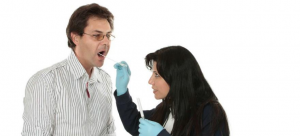Un guide sur les techniques de tests en laboratoire pour la pneumonie à nouveau coronavirus
2020-07-17
Un guide sur les techniques de tests en laboratoire pour la pneumonie à nouveau coronavirus
On February 21, la Commission nationale de la santé a publié un nouveau plan de prévention et de contrôle de la pneumonie à coronavirus (cinquième édition), et en annexe, a publié de nouvelles directives techniques pour les tests de laboratoire de pneumonie d'infection à coronavirus (cinquième édition).
Un guide sur les techniques de tests en laboratoire pour la pneumonie à nouveau coronavirus
In order to guide the disease control departments at all levels and other relevant institutions to carry out laboratory testing of new coronavirus pneumonia, this technical guide is specially formulated.
1. Specimen collection and processing
1. Écouvillons nasopharyngés: the sampler gently supports the head of the person being collected, holds the swab in one hand, the swab is attached to the nostril, and slowly deepens backwards along the bottom of the lower nasal canal. Fierce to avoid bleeding from trauma. When the tip of the swab reaches the posterior wall of the nasopharyngeal cavity, gently rotate it for one week (in case of reflex cough, it should stay for a while), then slowly take out the swab, and immerse the swab head in the preservation solution containing 2 pour 3 ml of virus (also available Use isotonic saline solution, tissue culture solution or phosphate buffer solution), jeter la queue, and tighten the cap.
2. Pharyngeal swab: the collected person gargles with physiological saline first, the sampling person puts the swab in sterile normal saline to moisten it (it is forbidden to put the swab in the virus preservation solution to avoid allergy caused by antibiotics), the head of the collected person Slightly tilted up, mouth widened, avec “ah” sounds, exposing the pharyngeal tonsils on both sides, the swab over the base of the tongue, and wiping the pharyngeal tonsils on both sides of the subject with a little hard back and forth at least 3 fois, and then at least 3 on the back wall of the pharynx Second, immerse the swab head in a tube containing 2 pour 3 ml of virus preservation solution (isotonic saline solution, tissue culture solution or phosphate buffer solution can also be used), jeter la queue, and tighten the cap. The pharyngeal swab can also be placed in the same tube as the nasopharyngeal swab. 3. Nasopharyngeal extract or respiratory tract extract: Use a collector connected to a negative pressure pump to extract mucus from the nasopharynx or airway secretions from the trachea. Insert the collector head into the nasal cavity or trachea, turn on the negative pressure, rotate the collector head and slowly exit, collect the extracted mucus, and rinse the collector once with 3ml of sampling liquid (you can also use a pediatric catheter to connect to a 50ml syringe Alternative collector).
4. Deep sputum: The patient is required to collect the coughed sputum in a 50ml screw plastic tube containing 3ml of the sample solution after deep cough. If the sputum is not collected in the sampling solution, add 2~3ml of the sampling solution or add an equal volume of sputum digestion solution before the test.
Sputum digestive fluid storage solution formula:
Before use, dilute the stock solution to 100 ml with deionized water. Phosphate buffer containing 1 g/L proteinase K can also be liquefied with an equal volume of sputum.
5. Bronchial lavage fluid: Insert the collector head into the trachea (about 30cm deep) from the nostril or tracheal socket, inject 5ml of saline, turn on the negative pressure, rotate the collector head and slowly withdraw. Collect the extracted mucus and rinse the collector once with the sampling liquid (you can also use a pediatric catheter to connect to a 50ml syringe to replace the collection).
6. Alveolar lavage fluid: after local anesthesia, insert the fiberoptic bronchoscope through the mouth or nose through the pharynx and insert it into the branch of the right middle lobe or the left lung tongue segment, and fit the tip into the bronchial branch opening, and slowly add the sterilization physiology through the tracheal biopsy hole Salt water, 30-50ml each time, the total amount is 100-250ml, should not exceed 300ml.
7. Fecal specimens: Take 1ml of the specimen processing solution, pick up the soybean specimen size and add it to the tube, gently suck it for 3-5 fois, let it stand at room temperature for 10 minutes, centrifuge at 8000rpm for 5 minutes, and suck the supernatant for detection.
The stool sample treatment solution can be prepared by yourself: 1.211 g Tris, 8.5 g sodium chloride, 1.1 g anhydrous calcium chloride or 1.47 g calcium chloride containing crystal water, dissolved in 800 ml deionized water, and adjusted to pH 7.5 with concentrated hydrochloric acid , Make up to 1000ml with deionized water.
Stool suspensions can also be prepared by dissolving stool samples using HANK’S solution or other isotonic saline solution, tissue culture solution or phosphate buffer. If the patient has diarrhea symptoms, leave 3 pour 5 ml of the stool sample, gently pipette and mix, centrifuge at 8000 rpm for 5 minutes, and draw the supernatant for use.
8. Écouvillon anal: gently insert a sterile cotton swab into the anus 3~5cm, then gently rotate and pull it out, immediately put it into a 15ml outer screw cap sampling tube containing 3~5ml virus preservation solution, jeter la queue, and tighten the tube cover.
9. Blood specimens: It is recommended to use vacuum blood vessels containing EDTA anticoagulant to collect 5ml of blood specimens. Determine the nucleic acid extraction with whole blood or plasma according to the type of nucleic acid extraction reagent selected. To separate plasma, centrifuge the whole blood at 1500-2000rpm for 10 minutes and collect the supernatant in a sterile screw-top plastic tube.
10. Serum specimen: Collect 5ml of blood specimen with vacuum negative pressure blood collection tube, let stand at room temperature for 30 minutes, centrifuge at 1500~2000rpm for 10 minutes, collect serum in sterile screw-top plastic tube.
Other materials: Collect according to design requirements.
(5) Packing of specimens
After the collection, it will be packed in the biosafety cabinet of the biosafety secondary laboratory.
1. All specimens should be placed in a sample collection tube of suitable size with a screw cap and a gasket that is resistant to freezing, and tightened. The sample number, type, name and sampling date are indicated on the outside of the container.
2. Put the sealed specimens in a sealed bag, each bag is limited to one specimen. The sample packaging requirements must meet the corresponding standards in the “Technical Rules for the Safe Transportation of Dangerous Goods by Air”.
3. For the transportation of external specimens, three-layer packaging shall be carried out according to the type of specimens and infectious substances of Class A or B.
(6) Preservation of specimens
Specimens used for virus isolation and nucleic acid testing should be tested as soon as possible. Specimens that can be detected within 24 hours can be stored at 4°C; specimens that cannot be detected within 24 hours should be stored at -70°C or below (if not- Stored at 70℃, temporarily stored in the refrigerator at -20℃). Serum can be stored at 4°C for 3 jours, and below -20°C for long-term storage. Special warehouses or counters should be set up to preserve specimens separately. Avoid repeated freezing and thawing during specimen transportation.
(7) Specimens submitted for inspection
Specimens should be sent to the laboratory as soon as possible after collection. If long-distance transportation is required, it is recommended to use dry ice and other refrigeration methods for preservation.
Negative nucleic acid test results cannot rule out new coronavirus infection. Factors that may cause false negatives need to be excluded, y compris: poor sample quality, such as respiratory samples from the oropharynx, etc.; samples collected too early or too late; not properly stored and transported And processing of samples; reasons for the existence of the technology itself, such as viral mutation, PCR inhibition, etc.
 flocked swab manufacturer
flocked swab manufacturer
















